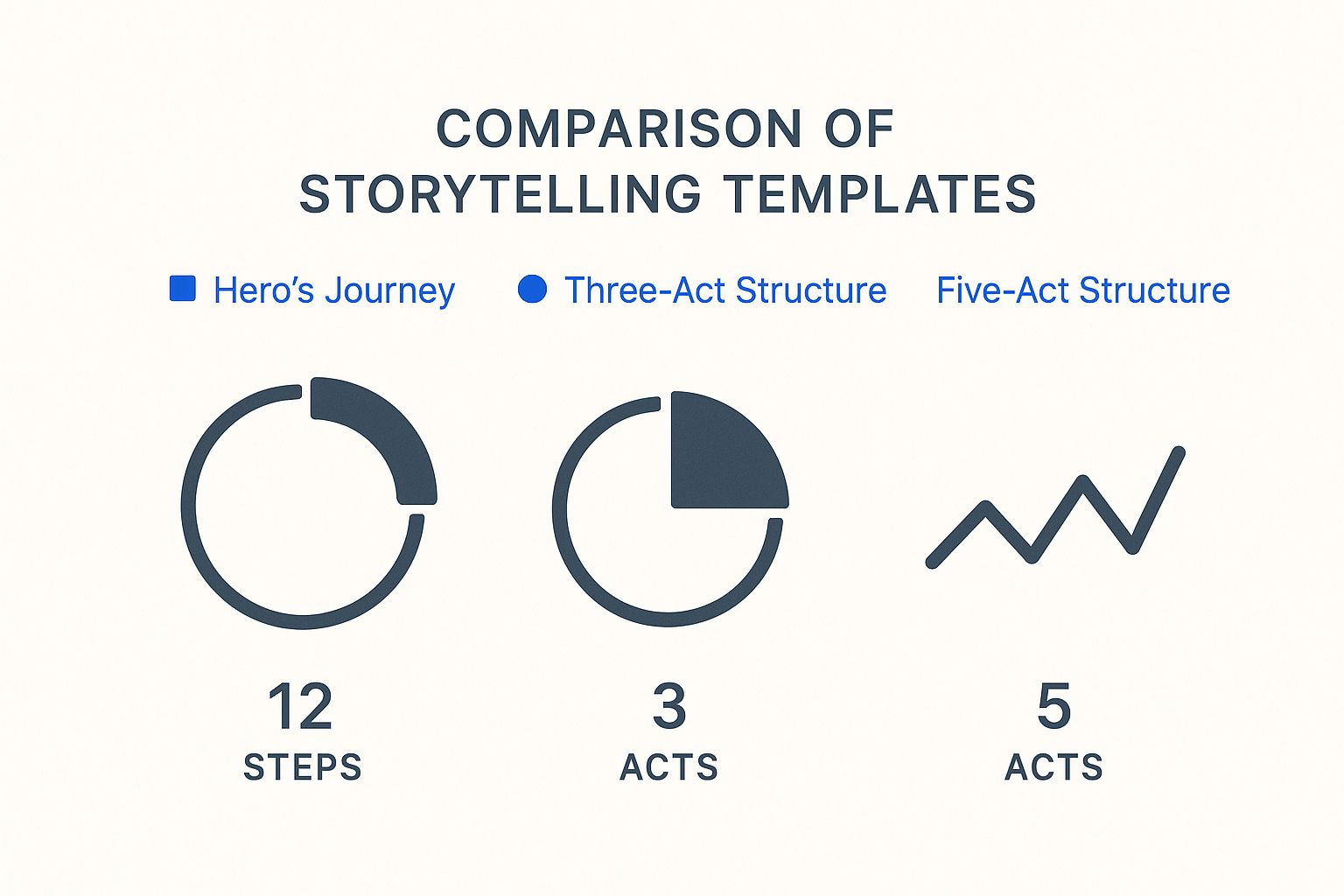What Makes a Storytelling Structure Template Actually Work
The real magic of a compelling narrative isn't just about grabbing a storytelling structure template off the shelf; it's about understanding why it resonates with people. A template isn't a paint-by-numbers kit. Think of it more like a flexible blueprint—a guide that lays out a psychologically proven path for your audience's emotions and attention. The best ones offer a framework you can mold to fit your own voice and message, not a set of rigid rules.
A solid storytelling structure template is a key part of a bigger content strategy framework, making sure all your stories help you reach your business goals. It’s about knowing which parts of the structure to lean on and which to make your own.
The Power of Flexibility
Great storytellers almost never follow a template word for word. They get the core principles—like building suspense and then providing relief—and use the structure to prop up their main idea. This adaptability is what makes a story feel fresh and authentic. This infographic gives you a glimpse into how different classic structures can vary in complexity.

As the visual shows, some templates are sprawling epics, while others are quick and to the point. This variety means you need to choose one that actually fits the story you want to tell and the audience you're trying to reach.
Evolving Structures for Modern Needs
Timeless models like the Three-Act Structure have been the bedrock of storytelling for ages. But today's communication, especially in data-heavy fields, has demanded that these frameworks evolve. A 2023 study found that 70% of data professionals in the US and Europe saw better audience engagement when they used more direct narrative models.
To give you a clearer picture, let's compare the classic approach with a more modern, data-focused one.
Classic vs Modern Storytelling Template Comparison
A side-by-side comparison of traditional narrative structures versus contemporary data-driven storytelling templates
| Template Type | Key Elements | Best Use Case | Audience Engagement | Complexity Level |
|---|---|---|---|---|
| Classic (e.g., Three-Act Structure) | Act 1: Setup, Act 2: Confrontation, Act 3: Resolution | Fictional narratives, character-driven brand stories, long-form content. | Builds emotional investment over time through rising tension. | Medium to High |
| Modern (e.g., Data Storytelling Arc™) | Setting, Hook, Insight, Resolution | Data reports, business presentations, case studies, short-form video. | Gets to the point quickly, holding attention with a clear, impactful insight. | Low to Medium |
The key takeaway here is the shift towards clarity and efficiency. Modern templates like the Data Storytelling Arc™ distill the classic five-act structure into four straightforward parts, a trend you can learn more about by exploring narrative models for data stories on effectivedatastorytelling.com.
In the end, a template only works when it serves the story, not the other way around. Knowing how to pick the right one and tweak it to your needs is a vital part of any good content creation process, a skill we dive into in our guide to content strategy best practices.
Matching Templates to Your Actual Goals

When you're looking for a storytelling structure template, it’s easy to grab the first one you see. But the real trick is matching the framework to what you actually want to accomplish. Are you trying to explain dense data, launch a new product, or teach someone a skill? Each of these goals requires a different narrative shape to connect with your audience.
For example, trying to shoehorn a data-heavy report into the character-focused Hero’s Journey is a recipe for a very confused audience. Before you even glance at a template, ask yourself a simple question: What does my audience believe right now, and what do I want them to believe after hearing my story? This helps define your narrative arc and quickly weeds out the templates that won't work.
Aligning Template to Purpose
Think of your goals as different destinations on a map. You wouldn't take a rowboat to cross a desert. In the same way, the template you choose is the vehicle that carries your message. You need the right one for the journey.
- For persuasion or sales: A problem/solution structure is a classic for a reason. It builds tension by spelling out a pain point your audience feels and then presents your idea as the satisfying resolution.
- For sharing data: You need a more direct approach. The goal here isn't a long, winding journey; it's about clarity and impact. This is where a specialized data storytelling template really comes into its own.
There's a good reason why 78% of marketing professionals say that a structured template is essential for making data compelling. Companies like LinkedIn have found huge success by weaving their statistics into clear narrative arcs, a technique shown to increase content sharing by up to 40%. You can see some excellent examples of these data storytelling methods from StudioGlobal.ai. The right template makes your data understandable and, more importantly, memorable.
Of course, getting good at this takes practice. If you want to build your skills, you can find some great exercises that explain how you can practice writing using these different structures.
Personalizing Templates Without Killing Their Magic
Finding the right storytelling structure template feels like a major win, but the real magic happens when you make it your own without breaking the core of what makes it work. It's a common misstep: some people stick to the template so closely that their story sounds robotic, while others change so much that they lose the psychological triggers that made it effective. The goal is to land in that sweet spot between originality and a proven framework.

This example shows a template that is clean and visually driven, striking a balance between structured data points and a compelling narrative. The structure is there to support the data, making complex information easier to follow without feeling restrictive.
What to Change and What to Keep
So, how do you inject your own personality while keeping the template's power? It comes down to knowing which parts are flexible and which are foundational to the story's success.
Flexible Elements (Go ahead and change these):
- Tone and Voice: This is where your brand's personality should come through. Are you witty and informal, or more authoritative and direct? Adapt the language to fit.
- The Opening Hook: The template will tell you to start with a hook, but your hook needs to be specific to your audience and the message you want to send.
- Specific Examples and Analogies: Ditch generic placeholders. Use examples and stories that resonate directly with your industry and your audience’s own experiences.
Foundational Elements (You should keep these intact):
- The Core Conflict-to-Resolution Arc: The journey from a problem to a solution is a classic narrative structure for a reason. Don't remove this central tension; it’s what pulls people through the story.
- The Emotional Journey: A good story builds suspense, creates connection, and provides a satisfying release. Maintain this rhythm to keep your audience engaged.
- The "Why": Never get rid of the part of the story that explains its purpose or the main insight from the data. This is your story's takeaway.
This is especially true when you’re weaving a narrative together with visuals. In fact, research shows that presentations using a storytelling template with a strong hook and supporting data achieved a 55% higher information retention rate. For students, that figure jumped to 62%, with many reporting a better grasp of the material when data was presented within a structured narrative. You can see more examples of how data storytelling templates drive engagement on shorthand.com.
By respecting the core structure while customizing the details, you can tell a story that is both powerful and authentically yours.
Putting Your Template Into Action

Moving from a great idea to a finished story is about practice, not just picking the perfect storytelling structure template. I've seen even experienced storytellers avoid jumping straight into a high-stakes presentation. Instead, they start small. Try mapping out a simple, low-pressure story first—like a recent project success or a funny personal anecdote—using your chosen template. This helps you get comfortable with the flow and builds confidence.
Think of your template as a recipe and your story elements—the facts, data points, and personal stories—as the ingredients. The real magic happens when you start combining them in a way that creates a coherent and satisfying narrative.
Organizing Your Narrative
The first practical step is to sort your key messages into the template's designated "buckets." If you’re using a problem-solution structure, this means clearly defining the "what is" (the current, painful state) and contrasting it with the "what could be" (the ideal future your idea creates). This simple act of sorting transforms a jumble of information into a journey with a clear purpose.
As you place your content into the structure, you'll start to see your story take shape. You might notice gaps or realize that a certain data point works better in a different section. This is all part of the process of refining your message and ensuring every piece contributes to the final impact.
To help you stay on track, a checklist can be an invaluable tool. It breaks down the process into manageable phases, from initial prep to the final review, ensuring you don’t miss a beat.
| Phase | Key Actions | Success Metrics | Common Pitfalls | Pro Tips |
|---|---|---|---|---|
| Preparation | Gather all data, anecdotes, and key messages. Select the most fitting storytelling template. | All necessary "ingredients" are collected. The template choice aligns with the story's goal. | Choosing a template before knowing the core message. | Create an "idea dump" document first, then organize it into the template. |
| Execution | Populate each section of the template. Write the first draft of the narrative, focusing on flow. | Each part of the template is filled with relevant content. The draft tells a cohesive story. | Sticking too rigidly to the template and sounding robotic. | Don't be afraid to tweak the template slightly to better fit your specific story. |
| Refinement | Read the story aloud to check for pacing. Get feedback from a trusted colleague. | The narrative sounds natural and conversational. Feedback is incorporated. | Skipping the feedback step due to time constraints. | Record yourself telling the story and listen back. You'll catch awkward phrasing you might miss when reading. |
| Final Review | Check for clarity, emotional impact, and a strong call to action. | The story is easy to understand and elicits the desired emotional response. | The story is interesting but lacks a clear "so what?" for the audience. | Ensure your final sentence tells the audience exactly what you want them to do or think next. |
This checklist isn't about rigid rules, but about providing a framework to guide your creative process. The biggest takeaway is to move from abstract planning to concrete action, ensuring your story is not just told, but truly lands with your audience.
A compelling narrative is a central part of any successful plan. When you're ready to share your story more widely, remember to think about where it fits into your overall content plan. Using a good website content strategy template can help you place your story for maximum effect. And if you're aiming to make a splash on social platforms, you'll need effective strategies to increase social media engagement to make sure your message gets the attention it deserves.
Tracking What Works and Fixing What Doesn't
A great storyteller is always refining their craft, and the same applies to using a storytelling structure template. Think of a template not as a final, rigid set of rules, but as the beginning of a conversation with your audience. The real magic happens when you listen to their response—both what they say and what their actions show—to make your next story even stronger.
It's about moving beyond just building the narrative to actively measuring its impact. It’s one thing to see your view count climb, but it’s another to understand why people stuck around. This is where you connect the dots between your story's framework and its real-world performance.
From Data to Decisions
To figure out what’s truly resonating, you need to look at how your audience interacts with your story. Are they leaving right after the opening hook? Does the climax trigger a wave of comments or shares? Pinpointing these moments helps you identify which parts of your template are doing the heavy lifting and which might need a little work. A clear dashboard is a huge help here, and if you're ready to go deeper, our guide on essential content performance metrics is a great place to start.
When you analyze your content against a model like Freytag's Pyramid, you can spot where your story might be losing steam. Maybe the rising action felt flat, or the resolution left your audience feeling unsatisfied.
Building Your Personal Template Library
After a while, you’ll start to notice patterns. Maybe you'll find that a problem-solution framework consistently drives results for your sales pitches, while a "Sparkline" structure—which contrasts "what is" with "what could be"—proves more persuasive for internal team presentations.
- Document your wins: When a story lands perfectly, save that structure. Make a note of the template you used, the specific tweaks you made, and the results it delivered.
- Analyze the misses: If a story doesn't perform as expected, don't just toss it aside. Figure out where you lost your audience. Was the introduction too long? Was the core conflict unclear?
By doing this, you’re not just guessing anymore. You’re building a tested library of templates designed for your specific goals and audiences, turning good storytelling into a repeatable, data-backed skill.
Advanced Techniques That Separate Pros From Amateurs
Once you've gotten the hang of the basics, you can begin to explore the methods that really make a narrative shine. This is the point where you stop just filling in a storytelling structure template and start weaving layers of meaning and emotion into your content. The pros don't just tell a story; they create an entire experience.
A powerful method is nested storytelling, where you place smaller stories inside a larger one. Think of a case study where each customer quote is its own mini-story, each one building on the main narrative. This gives your core message more weight and makes it far more believable.
Creating Hybrid Structures
Truly seasoned storytellers rarely stick to just one template. Instead, they borrow elements from different structures to build something perfectly suited for their specific message. It's less about following rigid rules and more about creating a unique framework.
- Multi-Perspective Narratives: Instead of sticking to a single point of view, try telling the story from several different angles. This is fantastic for showing the wide-reaching impact of a product or exploring the different sides of a complicated issue.
- Strategic Repetition: Repeating a key phrase or concept at just the right moments can create a memorable rhythm and hammer your main point home. Great speakers use this to build tension and provide a satisfying release.
- Building a Signature Style: With practice, you'll start to develop your own variations on standard templates, creating a style that becomes part of your brand. This consistency makes your work instantly recognizable and helps build a stronger bond with your audience.
These advanced methods are about seeing templates not as a set of constraints, but as a launchpad for creativity. They are a key part of building a strong narrative engine, a topic we explore further in our guide to making a content marketing strategy template.
Your Next Steps to Storytelling Success
Becoming a great storyteller isn't something you achieve overnight; it's a skill you build over time. Think of it less like a final exam and more like strengthening a muscle. Your path forward starts right now with consistent practice and getting good feedback.
Building Your Practice Routine
The only real way to get comfortable with a storytelling structure template is to actually use it. A great way to start is with low-stakes scenarios, which helps build your confidence before you have to deliver that big presentation.
- Focus on the fundamentals first: Start by getting a good handle on the Problem/Solution and Sparkline ("what is" vs. "what could be") structures. These two are incredibly useful and can be applied to almost any business situation you can think of.
- Make it a daily habit: Just 15 minutes a day is all you need. Use that time to outline a quick story. It could be about a recent project win, a tricky customer interaction, or an idea that popped into your head. The goal here is repetition, not writing a masterpiece.
- Find a practice partner: Ask a colleague or a friend to be your accountability buddy. Share your story outlines with them. This isn't about getting harsh criticism; it’s about checking for clarity. Did they get the main point? Was the story easy to follow?
Honing Your Craft
As you keep practicing, you'll naturally start to focus on the quality of your writing itself. For a deeper dive into making your narratives more powerful, these business writing guidelines offer some great advice. Remember, strong writing makes any structure shine.
This personal approach—combining proven templates with steady practice and feedback—is how you'll truly grow as a storyteller. Ready to create a blog that puts your new skills on display? With BlogMaker, you get a simple platform with built-in analytics and design tools, so you can focus completely on your story. Start creating with BlogMaker today and tell stories that connect with your audience.
SEO–ready, Analytics, No–code.
Your Content Publishing Engine
Deliver your SEO–driven content!
Visit BlogMaker.app



